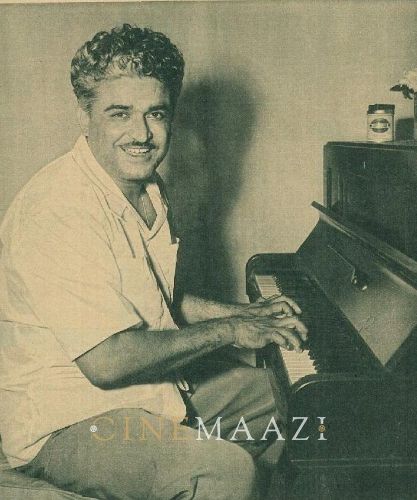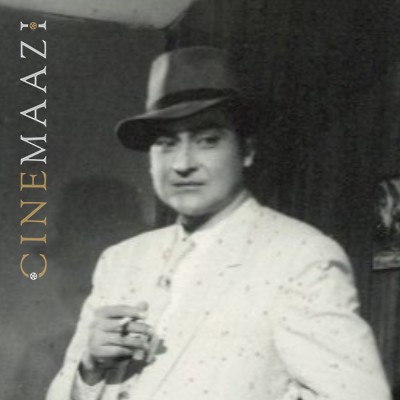C Ramchandra

Subscribe to read full article
This section is for paid subscribers only. Our subscription is only $37/- for one full year.
You get unlimited access to all paid section and features on the website with this subscription.
Not ready for a full subscription?
You can access this article for $2 , and have it saved to your account for one year.
- Real Name: Ramchandra Narhar Chitalkar
- Born: 12 January, 1918 (Puntamba, Ahmednagar)
- Died: 5 January, 1982 (Mumbai)
- Primary Cinema: Hindi
- Children: Yashwant Chitalkar, Dr Reshma Biniwale
Noted music director and occasional playback singer, C Ramchandra was of the belief that the relationship between classical and light music was like that between the body and the soul. He went so far as to declare, “When Indian classical music got lost in its own unending convolutions, when Technique developed at cost of the Spirit, music withered and died. Under the weight of the taan and the paltai, the heart of music was broken.” A piercing assessment by a man who had created some of the most popular songs across musical genres such as Yeh zindagi usi ki hai from Anarkali (1953), the non-film Ae mere watan ke logo, Dheere se aaja ri ankhiyan mein from Albela (1951), Katatay hain dukh mein yeh din from Parchhaain (1952), Tum kya jaano, tumhari yaad mein from Shin Shinaki Boobla Boo (1952), and Aankhon mein sama jao is dil mein raha karana from Yasmin (1955), among others. Ramchandra also sang some memorable songs such as Kitna haseen hai mausam with Lata Mangeshkar in Azaad (1955) and Shola jo bhadke in Albela, using just his surname, Chitalkar; besides singing and acting in Marathi films. A trailblazer and trendsetting music director as well as a trained classical singer, his orchestra had a mix of instruments ranging from the sitar, flute, tabla, and sarangi, to the clarinet, oboe, harmonica, and trumpet, which he employed deftly. In the manner of Benny Goodman, he introduced the alto sax in combination with guitar and harmonica in his compositions. While he included whistling in the famous song Aana meri jaan Sunday ke Sunday in Shehnai (1947), he employed a combination of bongo, oboe, trumpet, clarinet and sax for Shola jo bhadke in Albela. If he included rock rhythms in the title song of Shin Shinaki Bubala Boo (19520, he also scored the scat song Eena meena deeka in Aasha (1957).
Born Ramchandra Narhar Chitalkar on 12 January, 1918 in Puntamba, Ahmednagar, to a station master father, he went on to learn music under the guidance of Vinayakbua Patwardhan at the Gandharva Mahavidyalaya, as well as under Shankarrao Sapre of Nagpur. Fascinated with films, the young and good-looking Ramachandra came to Kolhapur, considered the birthplace of the Marathi film industry. He bagged a role as an extra in Lalit Pictures and played bit parts till he snagged a lead role in Naganand (1935). The film, unfortunately, failed at the box office. Ramachandra went on to act in Sohrab Modi's Said-e-Hawas (1936) and Atma Tarang (1937); however, he realised that acting might not be his future, after all. Approaching the legendary Modi again, he landed a job as harmonium player with the studio. Becoming an assistant to Meer Saab, the music director of Minerva Movietone, Ramchandra worked on films such as Meetha Zehar (1938), Jailor (1938) and Pukar (1939). In fact, he apparently even composed the classic song of Pukar, Tum bin kaun khabar le, as well as the popular Noor Jehan-rendered song, Aao mere pyare saanwariya in Lal Haveli (1944), which had been credited to Meer Saab.
Ramchandra had got his maiden break as an independent music director with Sukhi Jeevan (1942). While the film did not succeed, its musical style came in for positive attention. Composing two popular patriotic songs - Bharat pyara desh hamara in Sukhi Jeevan and Soya desh jaga do in his second film Muskurahat (1943), he established himself in the industry. He went on to compose for four films of producer Jayant Desai, going their separate ways after a difference of opinion over payment during the making of Tadbir (1945). He would also assist Anil Biswas in later years in films like Girls School (1949).
C Ramchandra went on to be signed by Filmistan, scoring music for 11 films of the studio. While his very first film Safar (1946) with Filmistan included memorable songs rendered by Mohammed Rafi such as Keh ke bhi naa aaye tum and Ab to hamare ho gaye iqrar karein na karein, the most popular was the duet, Kabhi yaad karke, gali paar karke, chali aana hamari galiyan. For Leela (1947), he composed a pleasing thumri, Maine lakhon ke bole sahey saanwariya tere liye, as well as Tum saath raho to main prem karoon sukh paoon. Among his songs emanating patriotic fervour, came the incomparable non-film song penned by Kavi Pradeep - Aye mere watan ke logo, rendered by Lata after the Chinese aggression.
For Filmistan’s Sajan (1947) directed by Kishore Sahu, and starring Ashok Kumar, Ramchandra recorded the song Hum ko tumahra hi asara, tum hamare ho na ho, with Mohammad Rafi instead of Ashok Kumar, who had evinced interest in singing it. The song became a big hit and marked the end of Ashok Kumar’s career as a playback singer. Ramchandra also replaced Master Ghulam Haider in Shehnai (1947), creating songs that captivated listeners such as Maar katar mar jana sung by Amirbai Karnataki in mujra style, and Jawani ki rail chali jaaye re rendered by Lata Mangeshkar. They were to form a successful professional association—Lata sang her first solo under Ramachandra's baton, namely Dil le ke bhaga, daga de ke bhaga. She rendered 248 songs (200 solo, 76 male duets, 18 female duets and four miscellaneous in 63 films) for Ramachandra and she even composed for a Marathi film, Ram Ram Pahune (1950), under his guidance. But the biggest hit from Shehnai was the Song Aana meri jaan Sunday ke Sunday, sung by Chitalkar himself and Shamshad Begum, becoming an overnight sensation.
With Ramchandra peaking in creativity, Patanga (1949) became a super hit courtesy its music, which included soulful Lata solos Dil se bhula do tum hamein, Jane wale tu ney armano ki duniya loot li, and Kabhi khamosh ho jana. The film also included the much-loved Mere piya gaye Rangoon. The 50s marked the golden high of Ramachandra's musical journey. If Samadhi (1950) had songs such as the Netaji Subhash Chandra Bose Indian National Army song, Kadam kadam badaye ja, it also had the dance number, Gore gore, O baanke chorey, kabhi meri gali aaya karo. Composing for Sangeeta and Khazana in 1950 and 1951 respectively, his music reflected Latin American/ Caribbean beats. He composed for comic situations in Sagai (1951) such as Jhukti hai duniya jhukane wala chahiye and Daddyji meri mummi ko satana nahi accha, and created charming compositions in Albela (1951) with Dil dhadke nazar sharmaye, Balma bada naadaan, the lullaby Dheere se aana re akhiyan mein (Lata), and the songs O beta ji kismet ki hawa kabhi naram kabhi garam and Haseeno ki mohabbat mein yahi anjaam hota hai, which he rendered himself.
A staunch devotee of Shri Sai Baba, C Ramchandra launched his own company, New Sai Productions, in association with his comedian friend Om Prakash. He produced three Hindi films namely Jhanjhar (1953), Lehren (1953), Duniya Gol Hai (1955), as well as two Marathi films, Dhananjay (1966) and Gharkul (1970). With a flood of offers coming in from south filmmakers, he gave music for MV Raman's Pehli Jhalak (1954), SS Vasan's Insaniyat (1955), Aasha (1957). Raj Tilak (1958), and Paigham (1959), for which he composed the unforgettable scat singing style Eena Meena Deeka, rendered by Kishore Kumar and Asha Bhosle separately. Other key work by Ramchandra is seen in Devta (1956) famous for its classical Raga Bhairavi-based song Kaise aoon Jamuna ke teer; Bahu Rani (1963) with the Lata-rendered Balma anari man bhaye and Main jagoon saari raat; Nausherwan-e-Adil (1957), V Shantaram's films Parchhaain (1952), Subah Ka Tara (1954), Navrang (1959), Stree (1961), and Yasmin (1955) which is memorable for its Talat-rendered songs. According to historian Manek Premchand, he had a vast oeuvre of songs based on classical ragas – from Raag Bageshri to Raag Pilu.
Ramchandra also composed for Marathi films and sang Sai bhajans. He went on to set up an Academy of Indian Music and gave public performances of his memorable melodies along with his disciples Pramila Datar and Kavita Krishnamurthy.
C Ramachandra passed away on January 5, 1982.









.jpg)



